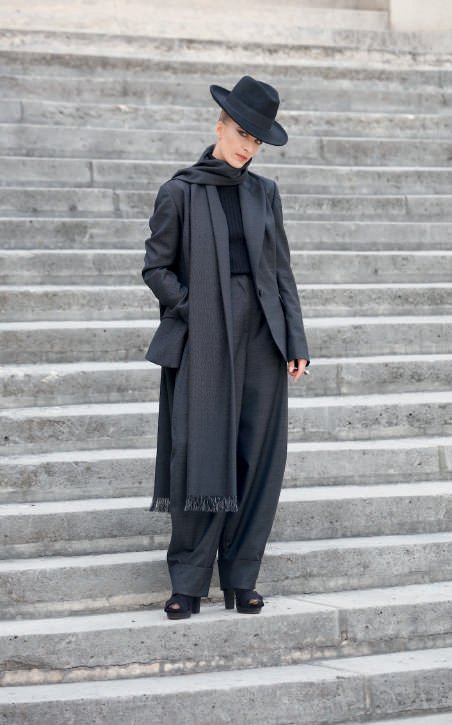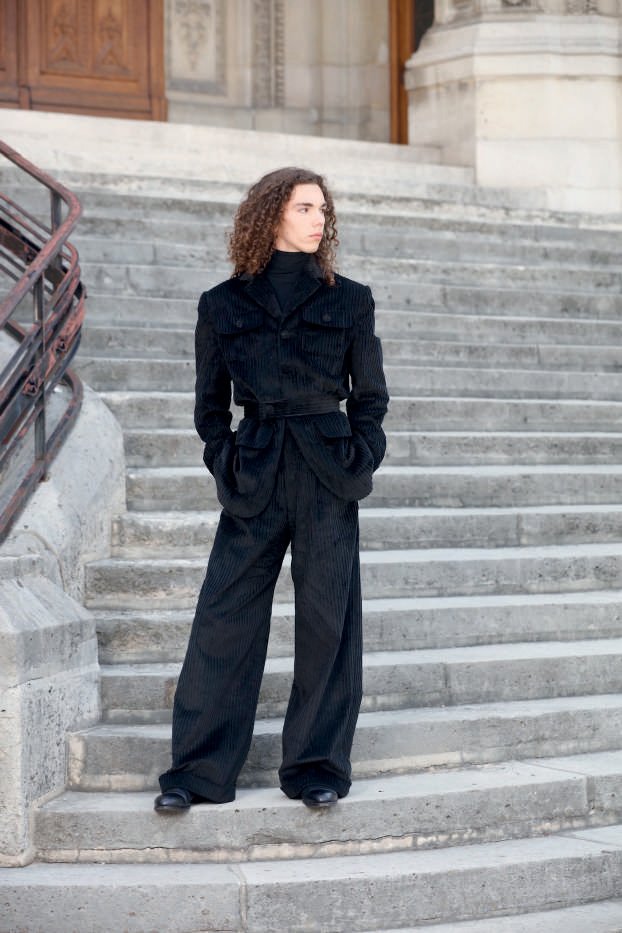Feature Highlight + Interview: Franck Sorbier Haute Couture
Master of Art (Maître d’Art) Franck Sorbier is a Paris fashion house that achieved haute couture status in 2005. After successfully working for Chantal Thomass and Thierry Mugler, the French fashion designer Franck Sorbier, who was born in 1961, presented his first collection in 1987.
Frank Sorbier is the only fashion designer in the world who has been awarded two prestigious honorary titles by the Government of the French Republic:
He is the one and only Maître d’Art (Master of Art) amongst all the fashion designers
He is one of the very few Grands Couturiers (Haute Couture Fashion label – only 14 designers currently own this label)
Instagram: Franck Sorbier
Official Website: Franck Sorbier Haute Couture
Photos Courtesy of Franck Sorbier
GR8T Feature Interview with the Extraordinary FRANCK SORBIER….
Hello Franck, how are you?
I am good. Thank you !
Even if, as you know, after a Haute Couture show, we take advantage of the presence of internationals, here in Paris to manager appointments, the preparations are very time-consuming and require a lot of energy both in terms of time and creativity.
Please briefly tell us about yourself?
I am a designer (Grand couturier) and Master of Art, and aslo Chevalier des Arts et des Lettres.
I began high end ready-to-wear at 1990 until 2000, which has been sold worldwide (Bergdorf Goodman, Saks Fifth Avenue in the US, The Swank in Hong Kong, Link in Singapore, Al Ostoura in Middle East, among others ...). My work on traditional laces treatment and the compression technic I have invented gave me the opportunity to enter the exclusive Haute Couture industry as French permanent member.
Dresses are typically considered a very feminine article of clothing; how do you think your creations fit into femininity and mix gender?
A complex question which refers directly to the current evolution of our societies and mentalities throughout the world. We are relaunching our high-end ready-to-wear business and have in mind on the pre-order principle to create the same men's and women's model with adapted proportions. It is to say that the woman takes her wardrobe from the man like George Sand, Mata-Ari ... George Sand, French writer of the XIXth century, dressed as a man to be able to enter the groups very masculine.
Movement is very central to your shows. What is the process behind finding textiles or materials that flow in the way you envision for a collection?
Generally, we use classical fabrics that we transform and give them new aspects, the final forms we want. There is a whole process of thinking, research upstream to transform, ennoble or even generate a new material. Then come the phases of embellishment, crumpling, dyeing with expertise in color treatment using color pigments. For example, the treatment of lace, a traditional technique of the House, is based on the use of cut lace patterns, reapplied to create new patterns.
Most of your shows draws from dramatic flair; where does your fascination with drama come from?
Above all, I like the romantic era which often features heroes and heroines with passionate feelings as well as the poetry that is part of the works of this period. One of the collections I made a few seasons ago, entitled "Poèmes" (2014-201 Winter Haute Couture collection), made reference to poet-phrases of French literature such as Baudelaire, Verlaine, Hélène Vascaresco ... Just like more recently, the collection film "Ode to Life" (2022 Summer Haute Couture collection) where the image of the tortured poet cradled the entire history of this collection. An idea on the very basis of questioning, of thinking: a recurring process within the House which results in Haute Couture creations and the iconographic approach of the collections. There is something Shakespearean about it.
Without forgetting, the staging and the places chosen for the presentations such as the theatres, the relationship to the theater and its scenic configuration offer sets of scenes, or even the place of the main courtyard of the last parade, borrowing of history.
Where and how do you find your creative inspiration?
Everywhere, the inspiration is in the air.
I am fascinated by pictures, movies, photographs.
I am, above all, very sensitive and attracted by the feelings, sensations and vibrations that surround us.
The news, too, cannot leave us indifferent.
It's not because Haute Couture refers to something exclusive that you have to abandon the rest and remain ignorant in your ivory tower.
A relationship and a concept that is, today, totally outside of time.
What is the thought process behind evolving your inspiration into an Franck Sorbier collection or piece?
All the designers have their "knacks".
Indeed, there are silhouettes or materials or characters that come back systematically because they correspond to personal leitmotifs.
Are there any themes or silhouettes you find yourself revisiting throughout your collections?
The creation must be both evolutionary and at the same time, translate the signature, the touch of the house and the brand
Who is the Franck Sorbier patrons and clienteles?
The House is based on a duo between Franck Sorbier, the designer and his wife Isabelle Sorbier, president of the brand and global coordinator of the company.
The ready-to-wear and Haute Couture clientele is mostly French.
However, the presence of the brand in the time of luxury ready-to-wear within the international department stores has made it possible to open up to an international clienteles; American, Asian and Middle Eastern.
Globalization has also contributed to the opening of borders and opening up to new international customers.
Haute Couture is another system based on an intimate and strong relationship with exceptional worldwide clients.
Do you feel explanation is necessary to understanding, appreciating, and enjoying your collection?
It depends on the collections, there are collections carried out to the end where we feel a satisfaction that pushes us forward. Other collections where we did not think of doing so: a feeling of regret which, however, pushes us to surpass ourselves. Be honest, the feeling that we want to feel is contentment and a kind of reward that are the fruits of all this accumulated work. It is also about developing techniques, challenging one's ideas, pushing the exercise of excellence and touching new creative and technical approaches. It's evolving while remaining yourself: achieving a balance, building and cultivating a story as you go along, like a common thread running through the collections. The most difficult thing is finally to manage to find one's own writing, one's own language: a form of identity expression, a DNA.
Known as the Guardian of Ancient Know-Hows; What role do you think technology will have in the future of fashion? And in your future collections?
We have already used new technologies during the Haute Couture 2012-2013 collection, in collaboration with Intel France. We had used 3D mapping technology to design an entirely virtual collection that could easily travel around the world and maintain a privileged and instant relationship with Haute Couture clients.
We had also used augmented reality technology thanks to Total Immersion / Intel France where selected Franck Sorbier Haute Couture models were photographed, scanned and virtually recomposed so that guests facing a 3-meter screen could wear the models thanks to sensor cameras. A challenging experience, placing us as prescribers facing Haute Couture mistreated by the economic system of fast fashion and the multiplication of so-called high-end and luxury product lines, distributed internationally, the same items present both in New York and to Shanghai via Dubai.
Even already, in 2009, we had used new technologies, inviting via internet and in the form of a digital invitation, the guests. The collection drawings had been digitized and "walked" on the screen. As such, we had won the Condénast special prize and the Strategies jury prize at the international advertising and endorsement festival in Méribel.
It should be noted that new technologies move very quickly, as do developments. It is an opportunity that must be seized while remaining guardians of Couture traditions and expertise which technology cannot replace: creative sensitivity and human subjectivity will always remain below, in the foreground in the face of technological intelligence.
And this, for the sake of transmission and preservation.
What is in place at the Franck Sorbier Maison to passing the “Ancient Know-Hows” to the next generation of Couturier?
Through my status as a Master of Art, my mission is to safeguard and transmit technical skills and Couture excellence to students and the new generation. This process is based on the notion of sharing and results in a long-term work of learning these techniques.
What advice would you give to the next generation of designers pursuing Haute Couture?
Work, passion, patience and curiosity. But above all, work. GR8T
















